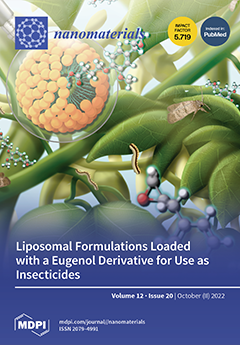The impact of a titania (TiO
2) support film surface on the catalytic activity of gold nanoparticles (Au NP) was investigated. Using the reactive dc-magnetron sputtering technique, TiO
2 films with an amorphous, anatase, and nitrogen-doped anatase crystal structure were produced for
[...] Read more.
The impact of a titania (TiO
2) support film surface on the catalytic activity of gold nanoparticles (Au NP) was investigated. Using the reactive dc-magnetron sputtering technique, TiO
2 films with an amorphous, anatase, and nitrogen-doped anatase crystal structure were produced for a subsequent role as a support material for Au NP. Raman spectra of these TiO
2 films revealed that both vacuum and NH
3 annealing treatments promoted amorphous to anatase phase transformation through the presence of a peak in the 513–519 cm
−1 spectral regime. Furthermore, annealing under NH
3 flux had an associated blue shift and broadening of the Raman active mode at 1430 cm
−1, characteristic of an increase in the oxygen vacancies (
VO). For a 3 to 15 s sputter deposition time, the Au NP over TiO
2 support films were in the 6.7–17.1 nm size range. From X-ray photoelectron spectroscope (XPS) analysis, the absence of any shift in the Au 4f core level peak implied that there was no change in the electronic properties of Au NP. On the other hand, spontaneous hydroxyl (–OH) group adsorption to anatase TiO
2 support was instantly detected, the magnitude of which was found to be enhanced upon increasing the Au NP loading. Nitrogen-doped anatase TiO
2 supporting Au NP with ~21.8 nm exhibited a greater extent of molecular oxygen adsorption. The adsorption of both –OH and O
2 species is believed to take place at the perimeter sites of the Au NP interfacing with the TiO
2 film. XPS analyses and discussions about the tentative roles of O
2 and –OH adsorbent species toward Au/TiO
2 systems corroborate very well with interpretations of density functional theory simulations.
Full article






